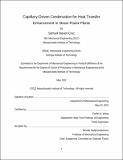Capillary-Driven Condensation for Heat Transfer Enhancement in Steam Power Plants
Author(s)
Cruz, Samuel Steven
DownloadThesis PDF (4.222Mb)
Advisor
Wang, Evelyn N.
Terms of use
Metadata
Show full item recordAbstract
Condensation is a phenomenon that is ubiquitous in nature and used to effectively transfer heat in many important industrial applications including thermal management of electronics, steam power generation, and natural gas processing. Industry relies mainly on filmwise condensation, where the condensate forms an insulating, thick liquid film on the condensation surface, posing a large thermal resistance. For almost a century, much work has explored developing surfaces that can promote the nucleation, growth, coalescence and effective shedding of mobile condensing droplets from surfaces, called dropwise condensation, which is known to enhance the heat transfer up to an order of magnitude. However, the requirement for ultra-thin coatings has hampered the wide adoption of this form of condensation as thin hydrophobic coatings degrade over time in various industrial applications. In this thesis, we model, fabricate, optimize, experimentally demonstrate a proof-of-concept for a novel condensation approach which we term capillary-driven condensation. The method consists of a hierarchical structure consisting of a hydrophobic porous membrane attached on top of a wicking structure that is firmly bonded to the condenser surface. The wicking structure and the membrane can be separately tailored to maximize the fluid flow in the wick and its effective thermal conductivity, as well as the maximum capillary pressure that the membrane can sustain to push fluid through a viscous pressure drop in the porous wick to an exit port. The geometry can be optimized to reduce the thermal resistance of the structure, as well as maximize the amount of condensate that can be removed passively by capillarity. To demonstrate the viability of this condensation method, we fabricated the proposed structure with highly-defined geometry utilizing silicon microfabrication techniques. The result is a surface which is able to constrain a thin film of condensate within a high thermal conductivity wicking structure while the top condensation surface appears dry despite sustaining condensation rates above those of filmwise condensation. The thickness of this layer and geometry of the membrane can be rationally designed to maximize the heat transfer coefficient even beyond dropwise condensation. Heat transfer measurements indicate a potential range of enhancement of ≈ 40% to ≈ 400% which is to be confirmed by more sensitive experiments that reduce error. The results from this thesis show a proof-of-concept and support the promise of capillary-driven condensation surfaces for various heat transfer applications.
Date issued
2022-05Department
Massachusetts Institute of Technology. Department of Mechanical EngineeringPublisher
Massachusetts Institute of Technology